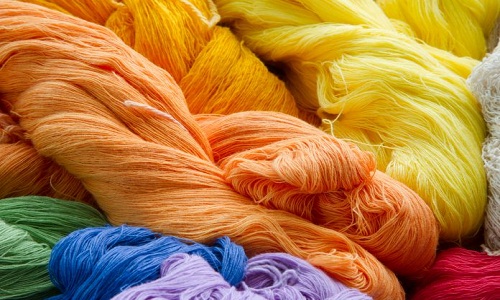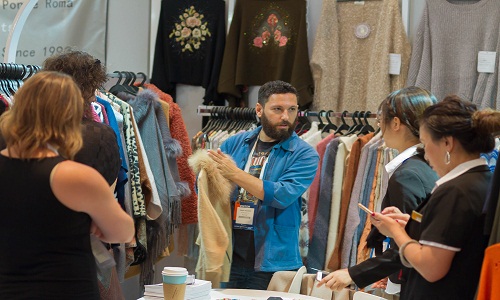FW
Spinnova, based in Finland, is a sustainable fiber company developing textile fiber directly out of pulp without harmful chemical processes. It has recently attracted new financing and investments, stepping into the next phase of the company’s growth story. Developing the world’s most sustainable textile fiber, the company will ramp up its pilot factory in Finland.
The investments will turn Spinnova into a new, Finnish export superstar. They will combine high-level sustainability and huge potential; for good as well as for profits.
The development of the Spinnova fiber has exceeded expectations. In addition to Finnish design house Marimekko, Spinnova has joint product development underway with several other partners. The fiber innovation has raised wide interest from global textile brands, many of which have committed to challenging sustainability goals.
Thanks to its financiers, starting the pilot factory and product development work are moving full speed ahead. Licensing the technology now being developed in Finland is the company’s most likely future business model, so piloting the technology concept on an industrial scale is now Spinnova’s main priority.
Spinnova’s majority shareholder is Brazilian cellulose company Fibria, which invested five million euro in the company in 2017. Spinnova’s ownership base has also changed.
Kay Ventures has teamed up with Hydra Micro Business Solutions to convert Karur into a global knitwear center. Karur is a hub for quality made ups and home textiles in Tamil Nadu. Tirupur is another major cluster known for cotton knitwear. Though these towns are just 100 km apart, growth of Tirupur has been phenomenal. While Karur’s export turnover is Rs 4000 crores a year, Tirupur has breached the Rs 40,000 crore mark. One of the key factors behind this stark difference is the size of segments they cater to. The size of the clothing sector is many times more than the home textiles market.
However, this is set to change because knitwear made an unnoticed entry into Karur sometime in 2016. Hydra is an economic framework that makes it possible for multiple entities to collaborate, think and function like a single entity on a single platform.
The Kay Ventures knitwear cluster in Karur annually produces 7.50 million pieces of knitwear, predominantly for leading domestic brands and export. Efforts are under way to increase the capacity to 20 million pieces per annum to accommodate more orders in the near term. Kay aims at expanding its knitwear capacity to 10,000 machines in the next four years.
Over 50 brands at INDX Intimate Apparel SS19 this year featured LYCRA fiber and fabrics technologies such as LYCRA fiber, LYCRA SPORT, LYCRA XTRA LIFE fiber and LYCRA BEAUTY fiber. Even established names such as Freya Active and Truimph incorporated the LYCRA technology into some of their ranges to further boost consumer trust in their products.
Acclaimed brands, Jockey and Sloggi also incorporated LYCRA fiber technology in many of their ranges to help influence the purchasing decision in this challenging category.
Another striking technology that the event featured was the LYCRA XTRA LIFE which has been incorporated by many popular brands such as Freya, Fantasie, Curvy Kate and David Swimwear in their swimwear to make it more durable and lasts at least one full season.
This year LYCRA brand also sponsored the event’s coffee plaza as well as its INDX networking reception.The LYCRA branding helped the coffee plaza to stand out and made it an easy place to meet potential new business prospects.
Cotton will be procured directly from farmers in Rajasthan by the Cotton Corporation of India (CCI) at the minimum support price (MSP) in the next cotton season and payments made to their accounts. Rajasthan is the first cotton-growing state in North India to make direct transaction mandatory for procurement at MSP.
The cotton season starts in October. Earlier, much of the cotton purchased by the CCI came through middlemen or aggregators in Punjab, Haryana and Rajasthan, with farmers not getting the government-set MSP. Over 12,000 farmers have been registered in Shree Ganganagar district and the process is under way in Hanumangarh and Bhilwara districts. India recently raised the MSP on medium-staple fiber cotton by 28 per cent and on long-staple by 26 per cent.
The hike is expected to help firm up prices in India compared to the last season, when those were lower compared with the global market. The CCI has started arrangements for ginning and storage of cotton for the ensuing harvesting season. Cotton availability for the 2017-18 season is estimated to be 416 lakh bales. This includes an opening stock of 36 lakh bales. Cotton in India is one of the most important commercial fibers and commodities exported due to its uses in the textile industry, mattresses etc.
India’s move to introduce rules of origin to protect its garment manufacturers might hurt Bangladesh’s exports to India. However, it will not be easy for India to impose any condition on duty-free facility as Bangladesh enjoys the trade benefit in India under the South Asian Free Trade Agreement.
Although India doubled import tax on more than 300 textile products to reduce its cheap imports from China, the Indian textile industry says due to the duty-free facility offered by India to Bangladesh, China is exporting textiles to India through Bangladesh. The industry had asked for rules of origin for duty-free imports.
Competition from China is forcing some Indian businesses, such as polyester production facilities, to run idle, leading to job losses. India is considering a fabric forward policy, where duty-free access to garments would be provided if the fabric is sourced from India.
Bangladesh says if India imposes conditions on duty-free market access on its products, Indian products would also have to face the same restriction in Bangladesh. India’s total textile imports jumped 16 per cent in fiscal year upto March 2018. Of this, about $3 billion were from China. Duty-free fabric from China comes to Bangladesh, gets converted and lands in India at zero duty.
Bangladesh's exports to China fell 26.79 per cent year-on-year in 2017-18. China has toughened certification regulations no longer accepts Bangladesh’s certification standards. So, Bangladeshi processed food exporters have to wait for days to receive certification from China, which is the main reason for the fall in exports.
Even in fiscal 2016-17, exports from Bangladesh to China had recorded a 17.48 per cent year-on-year increase. Moreover, the number of exportable items that Bangladesh has is low, although China has allowed duty-free access to 5,074 products from Bangladesh.
Bangladesh is a global leader in garment products but China does not allow duty-free import of all garments. As a result, exports of garments to China are also not increasing. Further China seeks high-end value-added items, something Bangladesh does not have a strong grasp on. China has also tightened visa regulations due to which, in most cases, small and medium company owners are being denied the scope to travel there.
Though China has a strong demand for jute, jute goods, leather and leather goods, Bangladeshi exporters lag behind due to their poor negotiation skills. Given the situation, Bangladesh is aiming for a free trade agreement with China. Currently, China is Bangladesh’s second largest export destination among Asian nations after Japan.
Apparel Textile Sourcing Canada (ATSC) is on August 20 to 22, 2018. ATSC has doubled in size from 2017 to include additional categories such as accessories, giftware, home electronics, footwear, luggage and houseware and general merchandise.
Almost 600 booths are at the show floor, featuring latest and greatest trends and unique offerings in apparel and textile from more than 20 countries, including Canada, China, Bangladesh, India, Pakistan, the US, the UK, Turkey, Switzerland, Spain, Nepal and Ukraine.
The event provides thousands of attendees with unprecedented networking and business opportunities with international suppliers on Canadian turf. It is also a major feat for local businesses that are poised to benefit from making unprecedented connections and securing deals with top-rate international suppliers.
During the exhibition, more than 20 lectures and forums will be held, and world-renowned industry experts will explain business knowledge, fashion trends and trade trends to the audience. More than 5000 visitors are expected to attend over the three-day event – now in its third year – including apparel and fashion executives, influencers, designers, retailers, importers, wholesalers, merchandisers, buyers and suppliers. A unique on-site business matchmaking service will be offered to bring overseas suppliers and contacts together with interested Canadian show attendees.
"A by-product of spinning, hydrogen sulphide (H2S) is a toxic gas that causes eye irritation, function impairment, and neurobehavioural changes. The toxic gas smells of rotten eggs. Other harmful chemical for health and environment are: Sodium hydroxide (NaOH) and sulphuric acid (H2SO4). NaOH is highly toxic if absorbed through inhalation, ingestion, or skin contact, and is known to cause corrosion, skin burns, and eye damage to workers who handle it frequently and without protection. H2SO4 is a highly corrosive, clear, and colourless oily liquid. It can result in adverse health effects from inhalation such as a burning sensation and shortness of breath. It is said that occupational exposure to sulphuric acid mists in combination with other acid mists can be carcinogenic. Lack of proper chemical management from producers’ side allows these toxic substances and gases to be released in environment, thus affecting the nature."
 Changing Markets Foundation, in its recent report ‘Dirty Fashion: On track for transformation’ has highlighted the harmful effects of viscose production and outlined a roadmap towards responsible viscose manufacturing. It says Carbon disulphide (CS2), a toxic and endocrine-disrupting chemical and the most important chemical in viscose production, is the criminal behind causing insanity and subtler personality changes. Apart from this, its prolonged exposure leads to damaged nerves of sensory capacity, kidney disease, Parkinson’s-like symptoms, heart attack, and stroke. The chemical can be present in both water and air.
Changing Markets Foundation, in its recent report ‘Dirty Fashion: On track for transformation’ has highlighted the harmful effects of viscose production and outlined a roadmap towards responsible viscose manufacturing. It says Carbon disulphide (CS2), a toxic and endocrine-disrupting chemical and the most important chemical in viscose production, is the criminal behind causing insanity and subtler personality changes. Apart from this, its prolonged exposure leads to damaged nerves of sensory capacity, kidney disease, Parkinson’s-like symptoms, heart attack, and stroke. The chemical can be present in both water and air.
A by-product of spinning, hydrogen sulphide (H2S) is a toxic gas that causes eye irritation, function impairment, and neurobehavioural changes. The toxic gas smells of rotten eggs. Other harmful chemical for health and environment are: Sodium hydroxide (NaOH) and sulphuric acid (H2SO4). NaOH is highly toxic if absorbed through inhalation, ingestion, or skin contact, and is known to cause corrosion, skin burns, and eye damage to workers who handle it frequently and without protection. H2SO4 is a highly corrosive, clear, and colourless oily liquid. It can result in adverse health effects from inhalation such as a burning sensation and shortness of breath. It is said that occupational exposure to sulphuric acid mists in combination with other acid mists can be carcinogenic. Lack of proper chemical management from producers’ side allows these toxic substances and gases to be released in environment, thus affecting the nature.
The initiatives
Taking cognizance of the prevailing situation, various viscose producers have partnered CanopyStyle initiative or signed ‘Detox’ commitments with Greenpeace. But these intents are yet to fructify. In order to further accentuate the matter, Changing Markets Foundation helped the global viscose producers by developing a Roadmap towards responsible viscose and modal fibre manufacturing. The roadmap is intended to help manufacturers drive the transition to closed-loop production, defined as a system that ensures emission controls and chemical recovery rates in-line with EU Best Available Techniques (BAT).
Greenpeace. But these intents are yet to fructify. In order to further accentuate the matter, Changing Markets Foundation helped the global viscose producers by developing a Roadmap towards responsible viscose and modal fibre manufacturing. The roadmap is intended to help manufacturers drive the transition to closed-loop production, defined as a system that ensures emission controls and chemical recovery rates in-line with EU Best Available Techniques (BAT).
Brands should ensure that their suppliers have all requisite environmental permits and comply with relevant national and local regulations. Producers should introduce plans for appropriate chemical management systems, in-line with EU BAT, with the ultimate goal of moving towards closed-loop production. Measures should be in-place to protect workers and local inhabitants from exposure to dangerous chemicals. Energy efficiency and greenhouse gas emissions reduction goals should be set. Environmental damage in the surrounding environment should be remediated.
Companies making headway
Lenzing, a global viscose producer, has implemented a safety, health, and environmental (SHE) compliance programme in which independent local experts check whether the companies comply with local legal regulations and the Group’s internal guidelines. Its production sites in Lenzing (Austria) and Nanjing (China) are in compliance with EU BAT values and have also been awarded EU Ecolabel certification. But the Purwakarta, Indonesia plant lags behind with no EU Ecolabel or EU BAT.
Renewable sources account for almost 50 per cent of Lenzing Group’s energy sources. Frontrunner is the Lenzing Austria site, where renewables make up 80 per cent of the site’s energy source. The rest is covered by gas and coal power. The other two sites in Purwakarta, Indonesia and Nanjing, China predominantly run on coal. While Lenzing has plans to shift from coal to gas power at Nanjing plant, the Indonesian site will depend on coal only.
Aditya Birla Group’s Nagda (India) unit conducts regular monitoring of air and water quality in accordance with Pollution Control Board (PCB) Server. Its Indo-Bharat (IBR) unit in Purwakarta, Indonesia, has all valid permits for the plant’s entire environmental management system, including legal compliance. Both units have installed exhaust systems to collect waste gas and direct it to chimneys or gas treatment systems. There is a gas collection system installed at the regeneration process, collecting all the gases. In order to keep their workers safe and healthy from exposure to gases, Birla has provided proper respiratory protection to them. It further necessitates all workers to undergo a comprehensive annual medical check-up. It also claims to have reduced specific energy consumption related to VSF manufacturing by more than 5 per cent at its units in over the past three years.
Taking leaf from such initiatives, seven major brands and retailers – Inditex, ASOS, H&M, Tesco, Marks & Spencer (M&S), Esprit and C&A – have pledged to integrate the Roadmap into their sustainability policies, while Next is in the process of signing up.
India is planning to change the rules of origin clauses in free trade pacts, including the South Asian Free Trade Agreement, as the country fears that with the US-China trade war escalating, Beijing may divert its manufactures into the Asian markets.
India’s trade deficit with China has already increased to $62.9 bn in 2017-18 out of a bilateral trade worth $89.6bn in the last fiscal. The country does not have any free trade pact (FTA) with India. However, policy makers feel that Beijing may use other countries in South East Asia and South Asia, such as Bangladesh, with which India has FTAs.
As India has not imposed any sourcing restrictions on less developed countries (LDCs), analysts believe China can well use the LDC route. Besides Bangladesh, within Asia, Nepal, Afghanistan, Myanmar, Maldives and Cambodia are LDCs.
The country has increased its basic customs duty on printed circuit boards, including populated, stuffed and loaded PCBs, as well as camera modules and connectors used in mobile phones to 10 per cent from zero, seen as part of a bid to kick-start the much hyped "Make in India" campaign.
"For many US apparel companies, China has long been the only sourcing destination for raw materials. But not anymore as per the fifth annual benchmarking study released by the US Fashion Industry Association, Vietnam and other countries are fast replacing China as major sourcing hubs for the US. The prospect of a looming trade war is compelling US apparel companies to shift production away from China. Though, China still remains the top sourcing destination for the US apparel industry, the country now accounts for only 11- 30 per cent of companies’ total sourcing volume, compared to 30 per cent–50 per cent in the past."
 For many US apparel companies, China has long been the only sourcing destination for raw materials. But not anymore as per the fifth annual benchmarking study released by the US Fashion Industry Association, Vietnam and other countries are fast replacing China as major sourcing hubs for the US. The prospect of a looming trade war is compelling US apparel companies to shift production away from China. Though, China still remains the top sourcing destination for the US apparel industry, the country now accounts for only 11- 30 per cent of companies’ total sourcing volume, compared to 30 per cent–50 per cent in the past.
For many US apparel companies, China has long been the only sourcing destination for raw materials. But not anymore as per the fifth annual benchmarking study released by the US Fashion Industry Association, Vietnam and other countries are fast replacing China as major sourcing hubs for the US. The prospect of a looming trade war is compelling US apparel companies to shift production away from China. Though, China still remains the top sourcing destination for the US apparel industry, the country now accounts for only 11- 30 per cent of companies’ total sourcing volume, compared to 30 per cent–50 per cent in the past.
Hurdles along the path
A major reason for this is the US’s protectionist trade policy, the industry’s top business challenge along with e-commerce competition and increasing production and sourcing costs. Compared to 2017, the challenges of rising costs and the need for alternative sourcing destinations have become much more immediate. Almost 54 per cent respondents in the US Fashion Industry Association believe increasing production or sourcing cost to be one of their top five business challenges this year, compared to only 34 per cent in 2017.
This is however not the case for larger companies who are more likely to have a diversified sourcing base. Over two thirds respondents reported they source from at least 11 different countries, and 26 per cent source from 20 different countries. In contrast, only half companies with fewer than 1,000 employees source from more than 10 different countries.
source from at least 11 different countries, and 26 per cent source from 20 different countries. In contrast, only half companies with fewer than 1,000 employees source from more than 10 different countries.
As for sourcing destinations, China, Vietnam, Indonesia, India, Bangladesh, Cambodia, Thailand, Philippines, Mexico and the US dominate the list of top 10 countries. Each of these sourcing destinations has its own strength and weaknesses. Geographical proximity of sourcing domestically or from Mexico is a major factor for US companies. Bangladesh and Vietnam, however, offer the most competitive pricing, even though this cost competitiveness is eroding. Furthermore, higher compliance risks associated with sourcing from South Asia give the US another competitive edge.
An overwhelming majority of this year’s respondents expect labor costs and raw material costs to increase. In the 2017 benchmarking study, only 73 per cent expected labor costs to increase. According to the report, wage levels started increasing in the later part of 2017 in almost all major sourcing destinations for US fashion companies, including Asia, Central America and Africa.
A change in approach
This year’s respondents also voiced concerns about social and environmental compliance, political unrest and insufficient resources for managing supply chain risks. Almost 85 per cent plan to devote more resources to manage sustainability and social compliance over the next couple years. Majority of these companies can map their supply chains down to Tier-II suppliers. Nevertheless, increased attention to supply chain sustainability suggests the apparel industry is continuously adjusting its sourcing strategy in response to social and business demands. The overall sourcing strategy for the US apparel industry is thus moving away from China, with more production shifted to Vietnam and Bangladesh. Cambodia and sub-Saharan Africa are also expected to play a bigger role.











